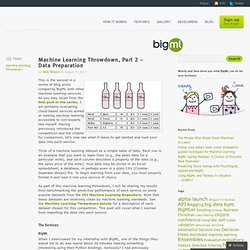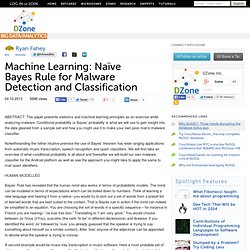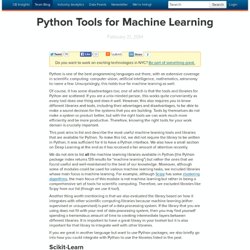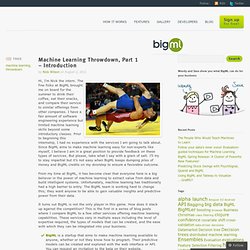Machine Learning
> Thefatih
Statistical Formulas For Programmers. By Evan Miller DRAFT: May 19, 2013 Being able to apply statistics is like having a secret superpower.

Where most people see averages, you see confidence intervals. When someone says “7 is greater than 5,” you declare that they're really the same. In a cacophony of noise, you hear a cry for help. Unfortunately, not enough programmers have this superpower. As my modest contribution to developer-kind, I've collected together the statistical formulas that I find to be most useful; this page presents them all in one place, a sort of statistical cheat-sheet for the practicing programmer.
Most of these formulas can be found in Wikipedia, but others are buried in journal articles or in professors' web pages. Send suggestions and corrections to emmiller@gmail.com Table of Contents 1. One of the first programming lessons in any language is to compute an average. 1.1 Corrected Standard Deviation The standard deviation is a single number that reflects how spread out the data actually is.
Where: SE=s√N 2. 3.
Is Intelligence Self-Limiting?
In science fiction novels like River of Gods by Ian McDonald [1], an artificial intelligence finds a way to boot-strap its own design into a growing super-intelligence.

This cleverness singularity is sometimes referred to as FOOM [2]. In this piece I will give an argument that a single instance of intelligence may be self-limiting and that FOOM collapses in a “MOOF.” A story about a fictional robot will serve to illustrate the main points of the argument.
On Systems and Boundaries: My Artificially Intelligent Rant. 10 Best Robotics and Artificial Intelligence Books. Nowadays, technologies are growing every day and making different kind of thinks that helps in your personal and professional life.

Today we are going to share books which are related to Artificial Intelligence and Robotics. Robotics is the branch of technology that deals with the design, construction, operation, and application of robots, as well as computer systems for their control, sensory feedback, and information processing.( Wiki). Artificial intelligence (AI) is the intelligence exhibited by machines or software, and the branch of computer science that develops machines and software with human-like intelligence.
(Wiki). We always try to share some useful stuff on my blog, A few days ago i have shared some online books like Lisp, Hakell and Computer Graphic programming books. 1) Rehabilitation Robotics 2) LIONbook. Image Processing with scikit-image. This is a post about image analysis using my new favorite Python import: scikit-image.
Take a couple words, alter them a bit and you've got a CAPTCHA. You've also got an image which is practically unidentifiable by even the most state of the art algorithms. Image analysis is hard, and even a simple task like distinguishing cats from dogs requires a large amount of graduate level mathematics.
Machine Learning on Rails with Ruby!
One of the primary goals of BigML is to provide scalable, high performance machine learning services as a plug and play service for any language.

Thanks to vigosan and flype we can today announce a beautiful Ruby gem for the Ruby community. These two veteran Ruby hackers have graciously provided a library with all of the necessary code enabling BigML in your next Ruby project. The library contains bindings for the BigML api. To get started, you need to require the library, and specify your BigML username and api key. From here, there are some easy steps to get a source loaded onto our servers, and to quickly create a dataset. You can retrieve existing resources using the “find” method. This is just a small sampling of the methods provided by the library.
Scalable Machine Learning with Hadoop. Machine Learning Throwdown, Part 2 – Data Preparation. This is the second in a series of blog posts comparing BigML with other machine learning services.

As you may recall from the first post in the series, I am primarily evaluating cloud-based services aimed at making machine learning accessible to non-experts like myself. Having previously introduced the competition and the criteria for comparison, let’s now see what it takes to get started and load your data into each service.
Machine Learning: Naïve Bayes Rule for Malware Detection and Classification. ABSTRACT: This paper presents statistics and machine learning principles as an exercise while analyzing malware.

Conditional probability or Bayes’ probability is what we will use to gain insight into the data gleaned from a sample set and how you might use it to make your own poor man’s malware classifier. Notwithstanding the rather intuitive premise the use of Bayes’ theorem has wide ranging applications from automatic music transcription, speech recognition and spam classifiers.
Python Scikit-learn to simplify Machine learning : { Bag of words } To [ TF. Building Machine Learning Systems with Python. Python Tools for Machine Learning. InShare2 Python is one of the best programming languages out there, with an extensive coverage in scientific computing: computer vision, artificial intelligence, mathematics, astronomy to name a few.

Unsurprisingly, this holds true for machine learning as well. Of course, it has some disadvantages too; one of which is that the tools and libraries for Python are scattered. If you are a unix-minded person, this works quite conveniently as every tool does one thing and does it well. However, this also requires you to know different libraries and tools, including their advantages and disadvantages, to be able to make a sound decision for the systems that you are building. This post aims to list and describe the most useful machine learning tools and libraries that are available for Python. If you are great in another language but want to use Python packages, we also briefly go into how you could integrate with Python to use the libraries listed in the post. Scikit-Learn Statsmodels PyMC. S. M. Ali Eslami / Patterns for Research in Machine Learning.
This page lists a handful of code patterns that I wish I was more aware of when I started my PhD . Each on its own may seem pointless, but collectively they go a long way towards making the typical research workflow more efficient. And an efficient workflow makes it just that little bit easier to ask the research questions that matter. My guess is that these patterns will not only be useful for machine learning, but also any other computational work that involves either a) processing large amounts of data, or b) algorithms that take a significant amount of time to execute. Disclaimer: The ideas below have resulted from my experiences working with MATLAB.
Other IDEs, languages or frameworks may have better solutions for the kinds of problems that I'm trying to address.
Does off-the-shelf machine learning need a benchmark?
I really like the blog post “Why Generic Machine Learning Fails” by Joe Reisinger of metamarkets .

His point is that successful industrial applications of machine learning are usually not based on black box algorithms being blindly fed data; rather they come from humans thinking deeply about the nature of the problem and iteratively working with a data set and algorithm—fiddling with features, tuning parameters, loss functions, etc. Usually the results are dependent on domain-specific insights that are not transferable to any other problem.
Learning about Machine Learning. Bradford Cross has posted an awesome blog post (edit: removed link, since Bradford took down the post) titled "Learning about Statistical Learning".

If you plan to work in ML, read the post, buy some of the books and work through them. Could save you years of work if you are systematic from the beginning (I wasn't), especially if you are self taught (I am). I work on different domains (Robotics/Computer Vision/Simulation) from Bradford and so have a different list of books. Please read Bradford's lists first.
Machine Learning Throwdown, Part 1 – Introduction. Hi, I’m Nick the intern.

The fine folks at BigML brought me on board for the summer to drink their coffee, eat their snacks, and compare their service to similar offerings from other companies. I have a fair amount of software engineering experience but limited machine learning skills beyond some introductory classes. Prior to beginning this internship, I had no experience with the services I am going to talk about.
Machine Learning: k-Means Clustering in Javascript Part 1. Machine Learning: k-Means Clustering Algorithm in Javascript On October 15, 2012 This article is part of the Machine Learning in Javascript series. The series covers some of the essential machine learning algorithms and assumes little background knowledge. There’s also a mailing list at the bottom of the page if you want to know about new articles; you can also follow me on twitter: @bkanber.
Are you just looking for the code example? Introduction and Motivation. A Tour of Machine Learning Algorithms. Machine Learning Throwdown, Part 5 – Miscellaneous. This is your application stack. The fourth level from the bottom represents cloud-based ML APIs. Oh, snap! In the fourth post of the series, I compared prediction functionality and performance between each of the services.
Machine Learning Throwdown, Part 4 – Predictions. We’re taking this throwdown to the level of a friendly athletic competition In the third post of the series, we looked at the types of models supported by each service. While some are useful for understanding your data, the primary goal of many machine learning models is to make accurate predictions from unseen data. Say you want to sell your house but you don’t know how much it is worth. You have a dataset of home sales in your city for the past year.
Stock Forecasting with Machine Learning. Almost everyone would love to predict the Stock Market for obvious reasons. People have tried everything from Fundamental Analysis, Technical Analysis, and Sentiment Analysis to Moon Phases, Solar Storms and Astrology.
Characteristics of Machine Learning Model. Machine Learning Throwdown, Part 3 – Models. What it takes to build great machine learning products. Machine learning (ML) is all the rage, riding tight on the coattails of the “big data” wave. Like most technology hype, the enthusiasm far exceeds the realization of actual products. Arguably, not since Google’s tremendous innovations in the late ’90s/early 2000s has algorithmic technology led to a product that has permeated the popular culture. That’s not to say there haven’t been great ML wins since, but none have as been as impactful or had computational algorithms at their core.
Netflix may use recommendation technology, but Netflix is still Netflix without it. There would be no Google if Page, Brin, et al., hadn’t exploited the graph structure of the web and anchor text to improve search.
Bayesian Machine Learning. Linear Algebra Cheat Sheet for Machine Learning. Max Sklar on Machine Learning at Foursquare. Machine Learning is Fun!
Machine Learning Throwdown, Part 6 – Summary. Data Science 101: The Power and Pitfalls of Clustering. Data-driven science is a failure of imagination. Predictive Analytics: Overview and Data visualization. No, you're not a data scientist. Expanding options for mining streaming data. Expanding options for mining streaming data. An Introduction to Real-Time Stock Market Data Processing. Working With Text Data. Data Analysis. MATLAB, R, and Julia: Languages for data analysis. Mark Hall on Data Mining & Weka: Weka and Hadoop Part 1.
Data Science 101: The Data Analytics Handbook. How to hire data scientists and get hired as one. What Is Bayesian/Frequentist Inference?
More than Everything You Wanted to Know About Data Mining. How To Build a Naive Bayes Classifier. NaiveBayes Classifiers 101. Probabilistic Data Structures for Web Analytics and Data Mining. RoadToDataScientist1.png 1,550×1,258 pixels. A List of Data Science and Machine Learning Resources. Devs Love Bacon: Everything you need to know about Machine Learning in 30 m. Why becoming a data scientist is NOT actually easier than you think. Becoming a Data Scientist - Curriculum via Metromap ← Pragmatic Perspective. An Introduction to WEKA - Machine Learning in Java. Wiki. Machine Learning Tutorial: The Naive Bayes Text Classifier. Machine Learning Video Library - Learning From Data (Abu-Mostafa)
Introduction to Artificial Neural Networks. Data Science in Python. Python Data Analysis Library ¶
A Large set of Machine Learning Resources for Beginners to Mavens - A Blog. Cocoa for Scientists (Part XX): Python Scripters...Meet Cocoa. Continuum Analytics. Recognize.im Publicly Launches API and Aims to Mobilize Image Recognition. Bayes Net By Example Using Python And Khan Academy Data.
Deep Learning
Why Google Is Investing In Deep Learning. Drools 5.4: Artificial Intelligence, A Little History. Democratizing deep learning with an iPhone app and open source SDK. Installing a Desktop Algorithmic Trading Research Environment using Ubuntu. Principal Component Analysis. GitHub · Build software better, together.
Frequentism and Bayesianism: A Practical Introduction. An optimization-based esolang.
The Data Science Debate: Domain Expertise Or Machine Learning?
Distributed Neural Networks with GPUs in the AWS Cloud. Machine Learning Software. How I made $500k with machine learning and HFT (high frequency trading)










